 Some history: Prayers with beads like the rosary may have begun as a practice by the laity to imitate the Christian monasticism of the Liturgy of the Hours, during the course of which the monks prayed the 150 Psalms daily. As many of the laity and even lay monastics could not read, they substituted 150 repetitions of the Our Father for the Psalms, sometimes using a cord with knots on it to keep an accurate count. During the middle ages, evidence suggests that both the Our Father and the Hail Mary were recited with prayer beads.
Some history: Prayers with beads like the rosary may have begun as a practice by the laity to imitate the Christian monasticism of the Liturgy of the Hours, during the course of which the monks prayed the 150 Psalms daily. As many of the laity and even lay monastics could not read, they substituted 150 repetitions of the Our Father for the Psalms, sometimes using a cord with knots on it to keep an accurate count. During the middle ages, evidence suggests that both the Our Father and the Hail Mary were recited with prayer beads.
In 13th century Paris, four trade guilds existed of prayer bead makers, who were referred to as paternosterers, and the beads were referred to as paternosters, suggesting a continued link between the Our Father (Pater noster in Latin) and the prayer beads.
It is reported that St. Aibert, who died in 1140, recited 150 Hail Marys daily. Also in the 12th century, the rule of the English anchorites, the Ancrene Wisse, specified how groups of 50 Hail Marys were to be broken into five decades of ten Hail Marys each. St. Louis of France (1214–70) prayed 50 Ave Marias each evening. In 13th century Paris, four trade guilds existed of prayer bead makers, who were referred to as paternosterers, and the beads were referred to as paternosters, suggesting a continued link between the Our Father (Pater noster in Latin) and the prayer beads.
Gradually, the Hail Mary came to replace the Our Father as the prayer most associated with beads. Eventually, each decade came to be preceded by an Our Father, which further mirrored the structure of the monastic Divine Office. The practice of meditation during the praying of the Hail Marys is attributed to Dominic of Prussia (1382–1460), a Carthusian monk, who called it “Life of Jesus Rosary”. He added a sentence to each of the 50 Hail Marys using quotes from scriptures. This practice became popular among Benedictines and Carthusians from Trier spreading into Belgium and France.
At this point you might be asking about the Dominicans. According to a Dominican tradition, in 1208 the rosary was given to St. Dominic in an apparition by the Blessed Virgin Mary in the church of Prouille. This Marian apparition received the title of Our Lady of the Rosary. In the 15th century Blessed Alanus de Rupe (aka Alain de la Roche or Saint Alan of the Rock), a Dominican priest and theologian, is said to have received a vision from Jesus about the urgency of reinstating the rosary as a form of prayer. Before his death on September 8, 1475 he reinstituted the rosary in many countries and established many rosary confraternities. By the 16th century, rosary confraternities were widespread among women who were otherwise excluded from other forms of confraternities.
In 1569, the papal bull Consueverunt Romani Pontifices by the Dominican Pope Pius V officially established the devotion to the rosary in the Catholic Church. Although it seems the term “rosary” only appeared in 1597. From the 16th to the early 20th century, the structure of the rosary remained essentially unchanged until 2002 when John Paul II instituted five new Luminous Mysteries.
And lastly…did you ever wonder why they are called “beads?” The English word bead derives from the Old English noun bede which means a prayer. Now you know.
For the record: Despite the popularity of Blessed Alanus’s story about the origins of the rosary, there has never been found any historical evidence positively linking St. Dominic to the rosary. The story of St. Dominic’s devotion to the rosary and supposed apparition of Our Lady of the Rosary does not appear in any documents of the Church or Dominican Order prior to the writings of Blessed Alanus some 300 years later.